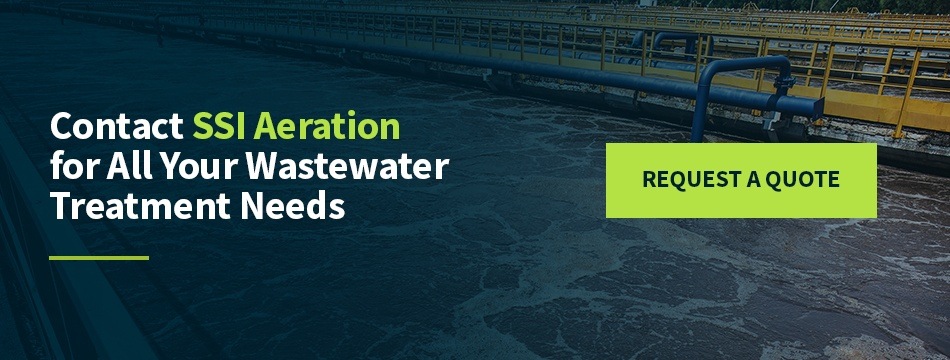How Do Wastewater Treatment Plants Work?
By: Tom Frankel
Post Date: January 20th 2021
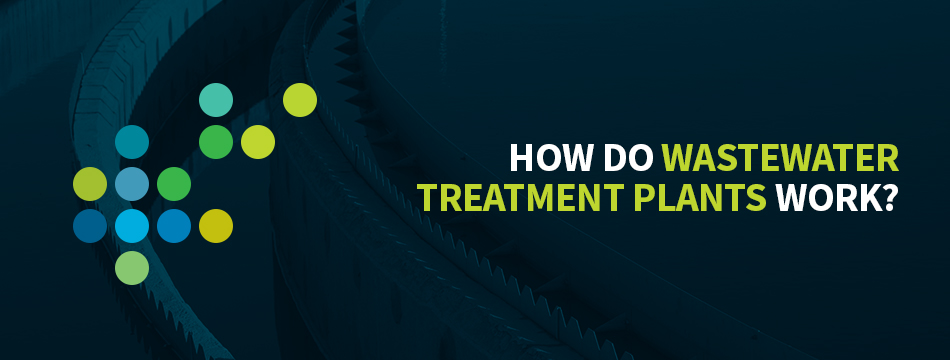
Wastewater treatment is vital for healthy communities and ecosystems. It provides clean, healthful water for industrial and municipal use, cuts down on disease transmission, and helps ensure a green, thriving environment for the coming generations.
How does this essential process work? The guide below will outline the stages of wastewater treatment, examine a wastewater treatment plant diagram and discuss some wastewater treatment methods in detail.
Table Of Contents
- What Is Wastewater?
- Why Do We Need To Treat Wastwater?
- Phases Of A Wastewater Treatment Plant
- What Happens To Wastewater After Treatment?
- Types Of Wastewater
- Contact Ssi Aeration For All Your Wastewater Treatment Needs
What Is Wastewater?
Wastewater, or sewage, is water people have used, either at home in their bathrooms, kitchens, laundry rooms, and yards or in industrial operations like agriculture or manufacturing. In the United States, sewage treatment plants process about 34 billion gallons of wastewater a day.
Untreated wastewater contains mostly water by volume. It also contains numerous impurities that make the water unsafe for reuse or to discharge back into the environment.
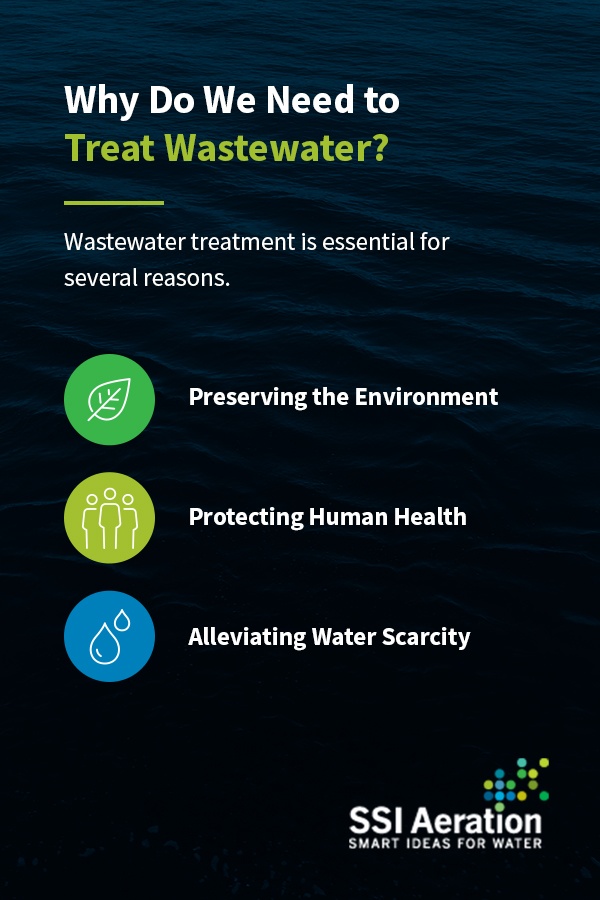
Why Do We Need to Treat Wastwater?
In the United States, most wastewater undergoes treatment. Worldwide, however, the practice of treating wastewater is not as common. According to the United Nations, about 80% of the world’s wastewater is untreated when it returns to the environment.
Wastewater treatment is essential for several reasons.
Preserving the Environment
Pumping untreated sewage back into the environment has a devastating ecological effect. The contaminants in sewage can kill plants and animals or make habitats unsafe to live in and water sources hazardous to drink. Contaminated wastewater from many industries, including the oil and gas industry, can have these adverse consequences.
Another common environmental effect associated with wastewater is the proliferation of harmful algal blooms. These blooms often form when wastewater containing high concentrations of nutrients like nitrogen or phosphorus reaches freshwater supplies. The nutrients collect in the fresh water in a process known as eutrophication.
Algae thrive on nitrogen and phosphorus, so as they consume these nutrients, they begin to overgrow their habitat. They consume much of the available oxygen, and they often contain harmful toxins. They ultimately tend to choke out the native vegetation and kill aquatic organisms like fish and shellfish.
Protecting Human Health
Discharging untreated wastewater into the environment has many adverse effects on human health. For instance, untreated sewage discharge is a factor in many of the approximately 1.6 million diarrheal deaths that occur every year. Around the world, 1.8 billion people use water sources contaminated with fecal matter, and the U.S. Centers for Disease Control and Prevention report that 88% of diarrheal deaths are attributable to unsafe water, insufficient sanitation, and inadequate hygiene practices. Farmland irrigated with untreated wastewater can also produce crops that are unsafe to consume.
Illnesses like cholera, dysentery, typhoid, and schistosomiasis are common in many parts of the world where sewage undergoes little treatment. These diseases kill more children than measles, malaria, and acquired immune deficiency syndrome (AIDS) combined.
In countries like the United States, where many of these diseases are less common, illnesses like cryptosporidiosis, giardiasis, and infectious colitis associated with pathogens like E. coli remain concerns.
Alleviating Water Scarcity
Water scarcity is also a serious problem in many areas of the world. The United Nations reports that two-thirds of the world’s population experience water scarcity during at least one month of the year, and intense water scarcity could displace up to 700 million people from their homes by 2030.
Alleviating water scarcity depends partly on processes for preserving and recycling water. Wastewater treatment is an invaluable part of these processes. Thorough, effective wastewater treatment often renders wastewater suitable for reuse in industrial processes or sometimes as drinking water if the treatment protocols are stringent enough.
Phases of a Wastewater Treatment Plant
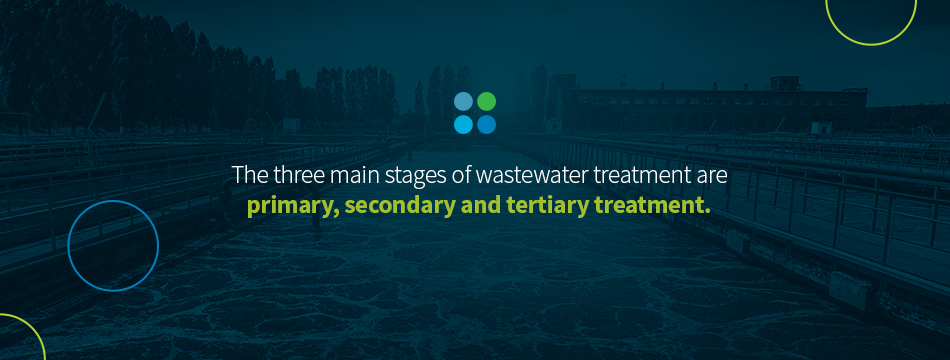
What are the three stages of wastewater treatment?
The three main stages of wastewater treatment are primary, secondary, and tertiary treatment. Many plants also add a pretreatment stage before the primary treatment process.
In a standard municipal sewage treatment plant model, the wastewater flows into pretreatment tanks before undergoing primary and then secondary treatment. Not all plants use tertiary treatment, but many do when they need their wastewater to meet a certain standard.
1. Pretreatment
Pretreatment primarily uses physical processes like filtration and settling to remove larger solid particles from the wastewater.
During pretreatment, wastewater flows into the treatment tanks and basins as an influent. Large bar screens filter out larger items like tree limbs, leaves, and plastic debris. Equalization tanks (EQ tanks) regulate water flow to promote settling, and grit chambers allow small particles like dirt, sand, gravel, coffee grounds, and eggshells to precipitate out.
Pretreatment often varies with the type of wastewater. If the wastewater contains a high volume of grease and fat, the treatment plant may skim those impurities off the water’s surface during pretreatment or use blowers to create an easily removable greasy froth. Other plants may save these steps until primary treatment.
Industrial wastewater treatment may also use chemical pretreatment methods instead of physical methods. These processes often change the pH of the water or alter the structures of the impurities it contains. The result is that the solid waste particles stick together and form heavier comps of waste that more readily precipitate out. These processes are known as coagulation and flocculation.
2. Primary Treatment
The next wastewater treatment plant process is the primary treatment. Its main goal is to use gravity and continued physical processes to remove solids from the wastewater.
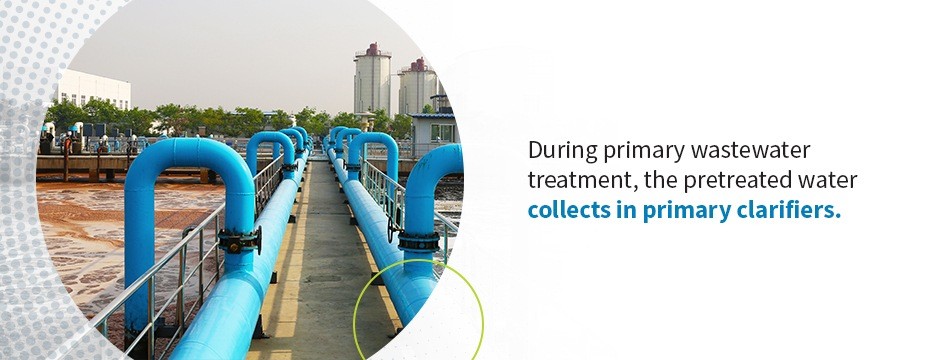
During primary wastewater treatment, the pretreated water collects in primary clarifiers. The wastewater sits for a while so further impurities can precipitate out. Mechanical scraping equipment may collect some of the solid matter and send it toward the sludge treatment equipment to be part of the activated sludge process, which we’ll discuss a little later on.
If the plant did not remove oil and grease during pretreatment, it will do so during primary treatment by skimming these fats from the surface. Some plants add alkali substances to the skimmed fats in a process known as saponification. Doing so is the first step in producing soaps and glycerol.
3. Secondary Treatment
Secondary wastewater treatment uses bacterial processes rather than physical ones. It uses beneficial microorganisms to break down more of the solid impurities in the wastewater.
The secondary treatment takes a few main forms.
Anoxic Treatment
The anoxic treatment takes place in the absence of free molecular oxygen, though some oxygen may be present in the form of nitrates, nitrites, or sulfates. This process is often used for the denitrification of wastewater with high nitrogen content. It uses microbes that do not require oxygen for their metabolic processes.
How does anoxic denitrification work? The nitrogen in the wastewater must usually be in the form of nitrate (NO3). The plant can convert nitrogen to nitrate using a trickling filter or suspended growth system. It then exposes the wastewater to certain microbes.To prevent molecular oxygen from interfering with the process, plants typically use tightly sealed reactors for their anoxic treatments. The microorganisms consume the nitrogen in the nitrate, leaving only the oxygen molecules behind.
Anaerobic Treatment
Anaerobic treatment also takes place in the absence of oxygen. Unlike anoxic treatment, in which molecular oxygen is absent but bound oxygen may be present in other compounds, anaerobic treatment occurs in the absence of all forms of oxygen. Anaerobic treatment often uses covered digestion lagoons in which the anaerobic bacteria can break down organic waste.
Aerobic treatment is useful for wastewater with a particularly high concentration of biodegradable solids — for instance, concentrated municipal wastewater, slurry from animal manure and food processing wastewater. Like anoxic treatment, it is also less energy-intensive than aerobic treatment because it does not require equipment to mix oxygen with the wastewater.
An additional benefit of anaerobic digestion is that it tends to produce methane, along with other biogas byproducts like carbon dioxide and water vapor. Many wastewater treatment plants can isolate the methane for reuse as fuel, sometimes even to power the plant.
Aerobic Treatment
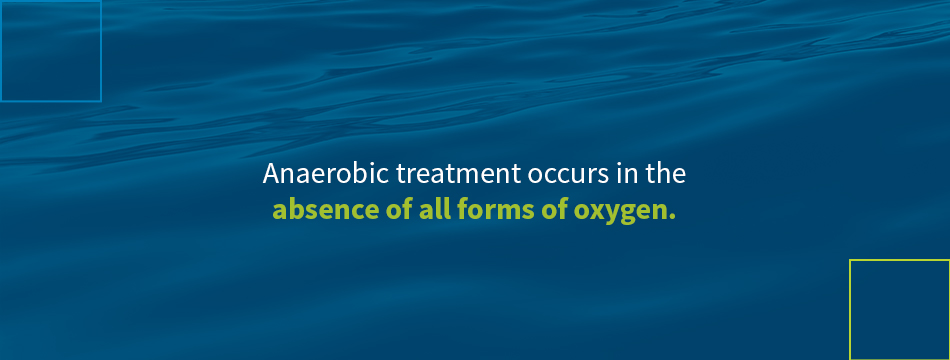
Aerobic treatment occurs in the presence of oxygen because the microorganisms involved require oxygen for their metabolic processes.
For aerobic treatment to take place, the wastewater treatment plant must-have equipment that can supply oxygen and incorporate it into the wastewater in a process known as aeration. The plant may have lagoons with surface aerators to mix air into the water. Or it may use aeration tanks full of rubber membrane or ceramicdiffusers, often disc- or tube-shaped diffusers. Air flows through pipes on the tank’s floor and into the diffusers, which contain numerous small perforations. These perforations emit the air as tiny bubbles. As the bubbles rise through the water column, they facilitate oxygen transfer and aerobic digestion.
Some plants use media filters for aerobic digestion. One common form of media filter system is the moving bed biofilm reactor (MBBR) system. An MBBR system uses a basin filled with thousands of tiny plastic media pieces. The pieces take up a significant amount of the basin’s volume — often 50 to 70%.
The design of the media pieces is optimal for encouraging bacterial growth. The pieces resemble wheels with many small spokes. This intricate shape provides an extensive, hospitable surface area for bacteria to grow on. Once the bacteria have taken hold, they form a slick biofilm on the media pieces. The pieces also have a density similar to that of water, so they can suspend themselves throughout the water column to maximize the available space. This arrangement helps the bacteria contact as much waste as possible to promote efficient digestion and reduce hydraulic retention time.
Plants typically also use activated sludge treatment, which is one of the most common aerobic processes. It works by using aeration and flocculation together.
As we have seen, wastewater flows into an aeration tank and becomes mixed with water during aeration. Afterward, the wastewater flows into a settling tank or secondary clarifier. There, some of the biosolids clump together and settle to the tank bottom, forming what the waste industry calls flocs, or a sludge blanket. The plant can then pump the sludge blanket back into the aeration tank. The many microorganisms the sludge contains will assist in the breakdown of more waste.
Activated sludge treatment requires significant space at the plant and is energy-intensive to perform. It is highly reliable and suitable for many different waste loads, however, so it is an exceptionally effective tool.
4. Tertiary Treatment
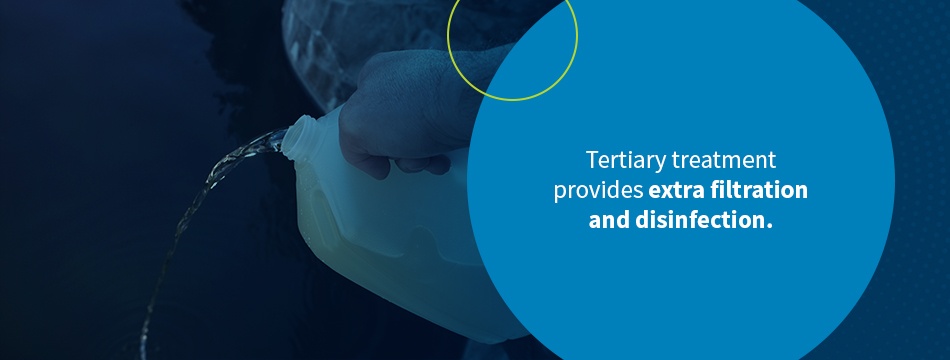
The tertiary treatment provides extra filtration and disinfection. Unlike primary and secondary treatment, which take place in most wastewater treatment plants, tertiary treatment is usually optional. Plants often use it when they must meet particularly stringent requirements for their effluent.
Tertiary treatment may rely on a few different processes — first filtration and then some form of disinfection:
- Filtration:Tertiary treatment often uses filters such as sand filters or carbon adsorption filters to remove lingering impurities from the wastewater. These filters may be disc, bag, granulated activated fiber (GAC) or drum filters.
- Chlorination: Many wastewater treatment plants then add chlorine to the water to sterilize it. Using chlorine is cost-effective, so many municipal plants rely on this method.
- Ultraviolet (UV) disinfection:Tertiary treatment may also use UV light to destroy or sterilize any remaining microorganisms in the wastewater and render them harmless.
- Ozone treatment:Some wastewater treatment plants also use ozone treatment for disinfecting. Ozone treatment is more effective than chlorine, but it is expensive, requires special corrosion-resistant equipment and produces toxic gases, so plants must weigh the costs and benefits of this treatment carefully.
- Ion exchange:Tertiary treatment may also involve the use of ion exchange, which swaps harmless ions for unwanted ones — much like a home water softener replaces undesirable calcium and magnesium ions with inoffensive sodium ions.
What Happens to Wastewater After Treatment?
Once the wastewater meets the applicable regulatory requirements, wastewater treatment plants can discharge the treated water back into the environment as effluent. The effluent mixes with the existing surface water or groundwater. In that form, it may one day be reused for irrigation or industrial processes or sent for treatment and used as drinking water.
In some cases, if the wastewater has undergone tertiary treatment, the plant can recycle the water, sending it on for reuse in water-intensive industrial or agricultural processes.
Types of Wastewater
Wastewater comes in a few different forms. Different types of wastewater require varied treatments, so sewage treatment plants need to tailor their treatment methods to their wastewater’s composition and properties.
1. Municipal Sewage
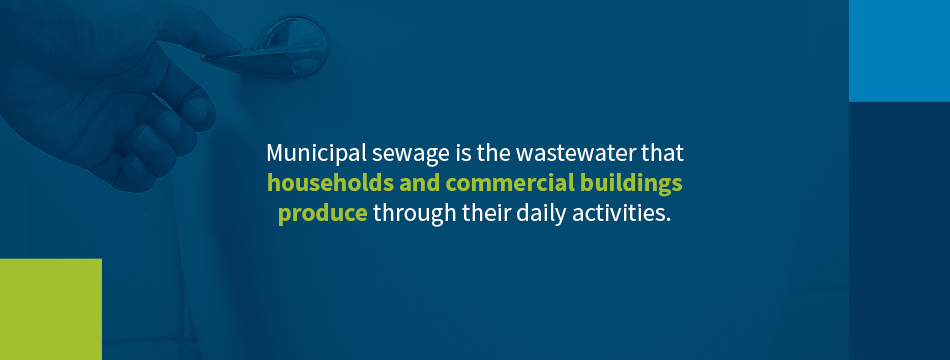
Municipal sewage is the wastewater that households and commercial buildings produce through their daily activities. This sewage comes from sinks, showers, toilets in structures like houses, apartments, restaurants, hospitals and office buildings.
Domestic sewage contains about 99.9% water by weight. In the SSI suspended stages, the remaining 0.1% consists of dissolved and suspended solids the wastewater treatment plant must remove. Even though this figure is very small, the dissolved and suspended solids contain microbes that would be harmful to human health and the local ecosystem if discharged into the environment untreated. The solids also generally contain soaps, detergents, plant nutrients and other organic matter.
2. Industrial Sewage
Industrial sewage is the wastewater that is leftover from industrial processes. Many manufacturing processes require water, and that water becomes wastewater once production is complete.
Industrial wastewater often contains a very high concentration of readily identifiable chemical compounds. Specialized wastewater treatment plants known as effluent treatment plants (ETPs) are useful for treating the chemical effluent that flows out from industrial manufacturing processes.
Industrial sewage may take many different forms. Below are a few industries that produce high volumes of industrial wastewater.
Pharmaceutical Manufacturing
Pharmaceutical wastewater comes from the manufacturing of medicines. This wastewater is highly complex and often has a high chemical content. It contains pharmaceutically active compounds, including antibiotics, hormones, surfactants, and volatile organic compounds (VOCs) that could be hazardous to human health and the environment if accidentally discharged. Antibiotics are of particular concern because of their potential to give rise to antibiotic-resistant strains of bacteria.
The drug residues in pharmaceutical waste also generally have high biological oxygen demand (BOD) and chemical oxygen demand (COD).
Textile Manufacturing
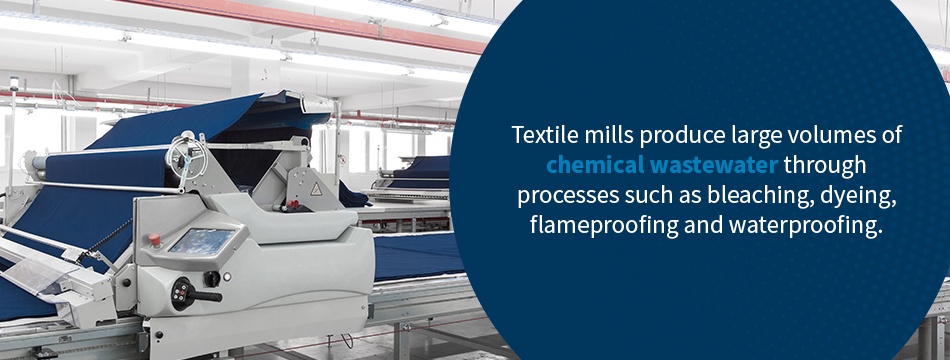
Textile mills produce large volumes of chemical wastewater through processes such as bleaching, dyeing, flameproofing, and waterproofing. Wool cleaning and finishing and yarn manufacturing also tend to generate chemical wastewater.
Textile wastewater often has high BOD and contains substances like oil and grease, chromium, phenols, and sulfides. With wool processing, animal fats are often present in the wastewater, as are any pesticides the sheep came into contact with.
Textile dyeing plants use various dyes, including acid dyes, basic dyes, direct dyes, mordant dyes, pigment dyes, solvent dyes, and vat dyes, which contribute an entirely different set of contaminants to their wastewater. The wastewater may also include substances such as pH buffers and dye accelerators. Wastewater from textile dyeing often contains heavy metals, oil and grease, phenols, and sulfides.
Pulp and Paper Manufacturing
The effluent from pulp and paper manufacturing often has high BOD and contains high concentrations of suspended solids. If bleaching has been part of the manufacturing process, the wastewater typically has high COD and includes substances like chloroform, dioxins, furans, and phenols.
Petroleum Refining and Petrochemicals Manufacturing
Petroleum refining and petrochemicals manufacturing, like all processes that deal with raw materials extracted from the earth, tend to produce wastes with high concentrations of heavy metals, including arsenic, cadmium, chromium, lead, mercury, and nitrates and nitrites. These wastewaters also often have high BOD and contain impurities such as ammonia, chromium, phenols, sulfides, oil and grease and various suspended solids.
Power Production
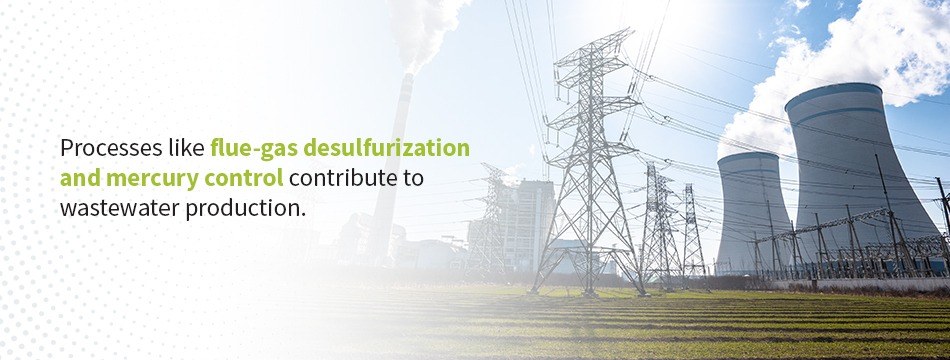
Power plants that rely on fossil fuels to generate electricity tend to produce tremendous volumes of wastewater, which often includes high concentrations of heavy metals. Processes like flue-gas desulfurization and mercury control contribute to this wastewater production. If the plant has wet scrubbers or similar pollution control devices, the captured contaminants usually end up in the wastewater stream as well.
Food and Beverage Processing
Food and beverage processing wastewater has unique characteristics. It has a low chemical content and is nontoxic and highly biodegradable, though it does tend to have a high suspended solids content and high BOD.
The composition of wastewater from food and beverage processing tends to vary widely with the type of production. Water from washing and processing vegetables tends to contain a high concentration of organic matter and particulate matter. Water from processing dairy products, on the other hand, contains high levels of fats, sugars, and other suspended solids. And water from processing meat often contains fats, blood, oil, and grease, as well as nitrogen and coliform bacteria from the intestines.
Other food and beverage processing activities, including bottling, product washing, and surface cleaning, generate additional wastewater.
3. Storm Sewage
Storm sewage is the water that runs off into city sewers after precipitation. Storm sewage often includes a high concentration of debris like dirt and twigs. It also contains a high concentration of organic matter that the water picks up as it sweeps along the ground.
Contact SSI Aeration for All Your Wastewater Treatment Needs
To improve your wastewater treatment operations with reliable equipment and products, make SSI Aeration your trusted source. SSI has the diffusers, preassembled PODs™systems and MBBR systems you need to retrofit an older facility or enhance a new one. And our experienced teams of engineers are happy to consult with you about your needs, answer questions, help you solve problems, and make your wastewater treatment more efficient and effective.
Contact us today to purchase wastewater treatment products or learn more.

Mr. Frankel co-founded SSI in 1995 with experience in design and distribution of engineered systems. He is in charge of sales, marketing and operations in the company. Mr. Frankel holds multiple US patents related to diffusers. He is a graduate of Washington University in St. Louis.


